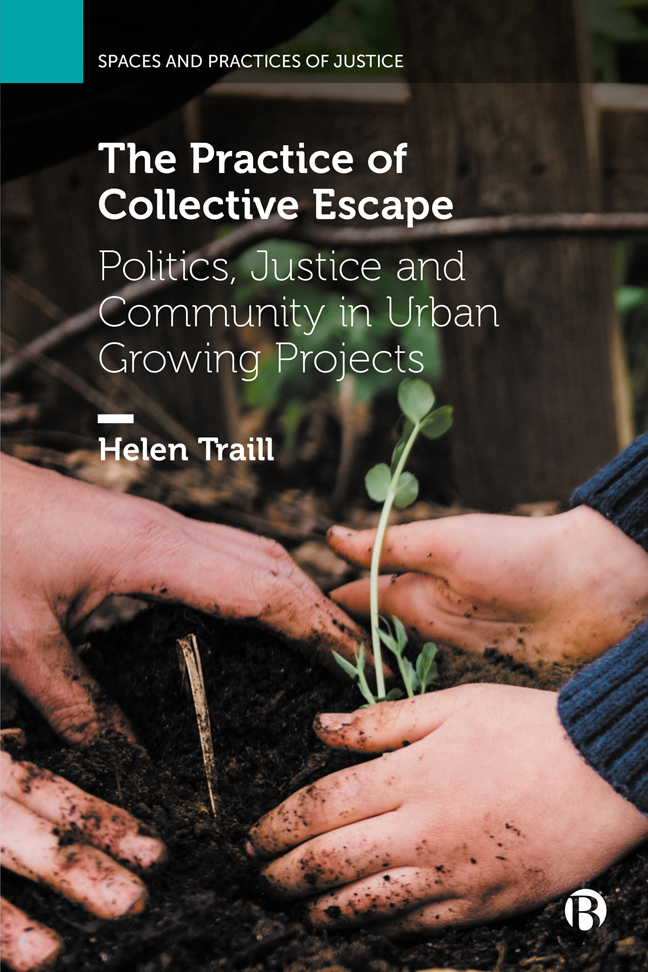Book contents
- Frontmatter
- Dedication
- Contents
- Series Preface
- Acknowledgements
- 1 Introduction
- 2 Urban Growing in Glasgow
- 3 The Rhythms of Urban Escape
- 4 Who Gets to Escape?
- 5 Ownership, Autonomy and the Commons
- 6 Escape into Responsibility
- 7 Field Dynamics and Strategic Neutrality
- 8 The Political Imagination of Common Justice
- 9 Escape, Crisis and Social Change
- 10 Conclusion
- Notes
- References
- Index
10 - Conclusion
Published online by Cambridge University Press: 23 January 2024
- Frontmatter
- Dedication
- Contents
- Series Preface
- Acknowledgements
- 1 Introduction
- 2 Urban Growing in Glasgow
- 3 The Rhythms of Urban Escape
- 4 Who Gets to Escape?
- 5 Ownership, Autonomy and the Commons
- 6 Escape into Responsibility
- 7 Field Dynamics and Strategic Neutrality
- 8 The Political Imagination of Common Justice
- 9 Escape, Crisis and Social Change
- 10 Conclusion
- Notes
- References
- Index
Summary
Community, politics, justice
The field sites of this book demonstrate the possibilities and tensions inherent to carving out places of collective escape in the city. Community underpins these escapist spaces, both as an idea and a set of practices, and intersects sometimes uncomfortably with urban justice, the right to the city, and the commons. This intersection complicates easy conclusions around the politics of communal growing projects. Attending to urban land politics, organizational pressures and the cultural implications of political interpretations demonstrates the breadth of action and beliefs, all of which might contribute to an understanding of the politics of such spaces. Questions of who belongs in a community garden in the West End of Glasgow thus have broader significance, giving us space to think through what it means to make a city and what stymies the remaking of the city in different ways. The organizations and movements in this book are attentive to justice through the idea of inclusion and opening up green spaces for broad usage. Yet there are tensions between doing the work to build green, social spaces and the exclusions and incursions of others, and such tensions are illustrative of the broader tapestry of social justice in the city as they are enacted through the seemingly mundane terrain of growing plants together.
That community, justice and politics are entangled in such a way is most evident through the analytically political work of building a commons as it sits against a sometimes limited political imaginary. While the political (or otherwise) status of communal growing projects is a well-worn terrain for debate, this needs to be understood on the one hand as emerging from both internally transformative capacities and a claiming of space in the city that we might understand as staking a claim to the city (Lefebvre, 1996); but also as restrained in its imagination in everyday life by organizational conditions and popular ideas around what politics means (often seen as divisive, especially around constitutional matters that were very much present in the field between Scottish independence referendum in 2014 and the Brexit vote in 2016). Politics is thus as amorphous a category as community at times; yet people at both sites often felt the moral content of their action, the common good, was fundamental to understanding the significance of what they were building in communal growing projects.
- Type
- Chapter
- Information
- The Practice of Collective EscapePolitics, Justice and Community in Urban Growing Projects, pp. 150 - 158Publisher: Bristol University PressPrint publication year: 2023

